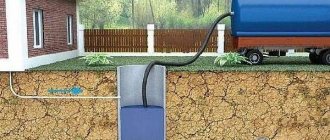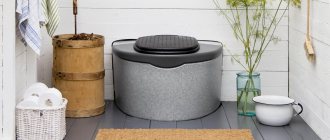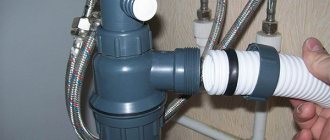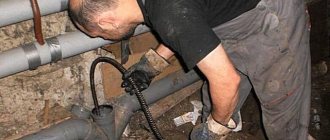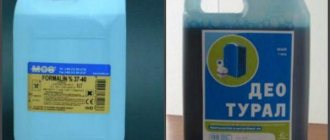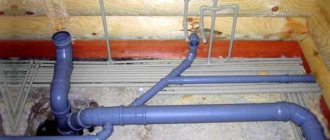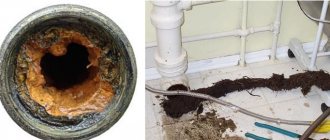One of the conditions for the proper operation of an autonomous sewer system is pumping out the septic tank. For this purpose, owners of private plots periodically use the services of vacuum cleaners who, using a special machine, remove liquid household waste. If it is not possible to provide convenient access for the vehicle to the treatment plant, an additional pipe is installed for pumping out from the septic tank, which allows dirty water to be collected from a considerable distance.
How often should a septic tank be pumped out?
The use of a septic tank is considered the optimal solution when arranging an autonomous sewage system for a country house. Such a treatment facility can easily cope with the collection and processing of liquid waste. At the same time, insoluble compounds gradually accumulate in the sedimentation tank, which have to be removed from time to time.
Independent removal of liquid waste is used quite rarely, given the complexity and danger of this activity, as well as the need to dispose of pumped out wastewater. Therefore, in this situation, it is more advisable to use the services of professional vacuum cleaners. On average, a car is called 1-2 times a year. In this case, the frequency of pumping depends on factors such as:
- volume and model of septic tank;
- number of permanent residents;
- intensity of sewerage operation;
- composition of household waste.
The septic tank must be pumped out in a timely manner, preventing the tank from overflowing.
Entrust the choice to specialists
offers a large selection of sewer pipes, the range of which can be found on the online store website. Each client, before deciding which pipes to use for connecting a septic tank and laying external sewerage, can take advantage of professional advice from our specialists. They are always ready to provide assistance in choosing products and make the necessary calculations, including taking into account operating conditions - to do this, you can call any branch of the company or use the feedback service directly on the website of our online store.
You can place an order and delivery of goods to the specified facility, in addition, order the service of professional installation of a sewer system of a country house and connection of a septic tank - our craftsmen are ready to perform this work quickly and efficiently.
Operating principle of a sewage disposal machine ↑
The main elements of any sewage disposal machine are: a reservoir (tank) for transporting liquid, a vacuum pump, a pipe for pumping water from septic tanks, sewer wells, drainage systems of car washes, natural reservoirs, etc. The operating principle of such equipment is as follows:
- One end of the pipe is connected to the machine, and the other is lowered directly into a container of liquid.
- Using a vacuum pump, water mixed with sludge is pumped into the tank. The process continues until the septic tank is completely empty or until the tank is full.
- Disposal of reinforced waste products is carried out in strictly designated areas, taking into account environmental standards.
Theoretically, the transport tank and pumping equipment can be installed on any vehicle chassis that meets the technical requirements. In Russia, as a rule, GAZ, KamAZ or ZIL are used for such purposes.
Machine for collecting and recycling wastewater based on GAZ 3309
The maximum distance within which water can be drawn depends on the length of the pipe (hose). The standard length, regulated by the manufacturer, usually varies between 6-15 m. By individual order, this parameter can be increased to 25 m. Some sewer trucks use additional hoses, which allow increasing the length by another 5-10 m. However, even this is sometimes not possible enough to clean a septic tank located at a great distance from the roadway. In this case, additional measures will be required from the owners of the site.
Types of vacuum cleaners
It is important that the tank capacity of the machine matches the volume that needs to be pumped out. The smaller the car, the cheaper it is to pump out. The minimum volume of a GAS tank is 2 m³. The compact machine will fit into narrow passages and gates. Its light weight allows it to be driven onto paving slabs. Can pump out the volume of approximately 1 concrete ring with a radius of 1.5 m.
The most common car is GAZ with a tank volume of 4 m³. The septic tank hatch should be located at a maximum distance of 16 m from the tank.
Almost all brands of sewage disposal machines are equipped with hoses 10-15 m long. But often this is not enough. Therefore, owners equip their equipment with additional hoses; the average hose length is 20-25 m. The longer the hose, the greater the power loss. If the distance from the pumped-out container to the intended location of the machine is more than 25 m, a vehicle with a high-performance vacuum pump is required.
An important characteristic of a sewer pumping machine is fuel consumption. Japanese diesel models are practical because they do not consume fuel during pumping. They are equipped with convenient, automatically collapsing hoses. The tank of such a machine is durable because it is galvanized on the inside.
Installation of a pipe for pumping water from a septic tank ↑
In order not to depend on the length of the sewage hose, a pipeline is laid from the treatment plant to allow the removal of wastewater. In this case, the pipe for pumping out of the septic tank must correspond to a certain type and technical parameters.
Why you can’t use pipes for internal sewage ↑
During the process of pumping out liquid, a negative pressure or, in other words, a vacuum is created inside the pipe. At high vacuum, the pipeline tends to compress, and in this situation, the reliability of the system will depend on the strength of the material used and its suitability for working in such conditions.
Conventional gray sewer pipes, which are used for indoor installation, have a wall thickness of 2.2 mm, which is insufficient to work under pressure or vacuum conditions. Therefore, such a pipeline is used exclusively for non-pressure systems.
So, what kind of pipe is needed for pumping out a septic tank? For such purposes, you should use special pressure pipes with increased wall thickness or an orange PVC pipeline, which is intended for outdoor placement.
Orange pipes have a multilayer structure, which increases their strength and reduces thermal conductivity
Correct pipe diameter for pumping concrete waste ↑
The diameter of the pipeline must correspond to the size of the suction pump hose. Theoretically, the size of the pipe for pumping water from the septic tank can be smaller. However, it should be borne in mind that in this case the pump will need more effort to create the required pressure, and it will work with increased load.
Since the diameter of the suction machine hose is usually 100-104 mm, it is advisable to use a 110 mm PVC pipe. The interpipe space can be covered with a wet rag or an adapter can be used to seal the pipeline and hose.
Installation technology ↑
Pipe laying must be carried out taking into account the following rules:
- The pipeline is laid at a shallow depth from the septic tank to the roadway. The slope is towards the septic tank.
- The pipe cuts into the septic tank at a depth of about 1 m and, using an angle, turns down, resting with an oblique cut (45°) on the bottom.
- Exit to the street is realized using a 90° corner, which is located in a small pit near the intended entrance of the sewer truck.
A pit with a pipe for pumping out a septic tank is usually located near the road
Such a system will make it possible to remove concrete waste even when the septic tank is significantly removed from the roadway. In this case, the pipeline does not need to be buried below the soil freezing level. Firstly, it is filled with liquid only during the pumping process, and secondly, pipes for external sewage can easily withstand low temperatures.
This article provides general recommendations for installing pipes for removing liquid waste. If there are specific operating conditions for an autonomous sewer system, it is better to additionally consult with specialists.
Pumping out cesspools - ways to clean a cesspool
Pumping out cesspools with your own hands
The classic cesspool will remain for a long time one of the most common options used in the construction of autonomous sewer systems. Its construction is a fairly economical undertaking, but the use of a cesspool as a container implies its regular pumping.
Methods for pumping out sewerage
The most popular environmental service, in the form of pumping out a drainage pit, uses three main methods:
- Contacting a special service (calling a sewer truck to your home).
- Independent use of fecal pumps.
- Manual pumping.
When ordering a car, you need to take into account that the owner of the house will incur material costs, but the positive aspects here will be: urgency of the call, speed of execution, guarantees, high-quality work of specialists and personal time savings (you won’t have to bother with it yourself).
The first method not only pumps out sewage, but also flushes the sewer pipes and well, and cleans the bottom of the pit from silty inclusions.
IMPORTANT! The sewer well must have convenient access. This must be taken into account when installing external sewerage.
The second way to remove sewage is to use a sewage pump with a grinder. Such special pumps have advantages over conventional water pumps. Water pumps do not have a filter, so if they are used to clean drains, they will quickly become clogged and break.
Sewage pumps are selected according to the type of engine cooling, the diameter of the outlet, the ability to achieve maximum pressure, the location of the pipes and the ability to carry out repairs without dismantling. Such products make it easier to pump out wastewater of any degree of contamination, are easy to use and have guaranteed durability.
The third option is the manual method of cleaning waste containers, which must be performed by 2 people. The disadvantages of this method include the heaviness and dirt of the work, which involves scooping sewage outwards using a shovel, rope and bucket. The wastewater will then need to be disposed of and carried off-site. Sewage waste is collected in a special container.
In addition to the above pumping methods, 3 types of pumping are used:
- hydrodynamic;
- vacuum;
- emergency.
Hydrodynamic pumping using special equipment involves removing all blockages and deposits using a hose through which water is supplied to the sewer pipes under high pressure. The pumped out wastewater is transported outside the territory for subsequent discharge.
Emergency pumping is used in case of unexpected accidents. It is also carried out using special equipment (vacuum trucks). Any powerful fecal pumps or hoses can help here.
Vacuum cleaning is carried out using a high-power vacuum pump. This cleaning removes all silt deposits well. This special equipment can always be rented when planning independent pumping of pits, wells and septic tanks. Waste is collected in a tank.
IMPORTANT! The advantage of calling a sewer truck is that the specialists will do a good job of flushing out the sediment at the bottom of the collector.
The need to pump out cesspools
The use of cesspools in autonomous sewer systems will allow you to significantly save money during the construction phase. But in the future, such a structure, unlike a septic tank, will require regular maintenance.
You might be interested in information about how long a tire drain pit will last
A cesspool is just a storage tank into which sewage flows. No cleaning takes place in such equipment; sewage is stored in a cesspool until it is emptied.
Cesspool with brick walls
There are certain sanitary rules for the construction and maintenance of cesspools on personal plots. So, pits should be located no closer than 15 meters from residential buildings. The drainage pit itself is a potential source of pollution of both the surrounding soil and the air in the area of its head. Untimely cleaning of cesspools can lead to adverse environmental consequences. In addition, an overflowing sewer pit is a source of strong unpleasant odors, which significantly reduces the comfort of living in your own home.
Tips for installation and use
It is imperative to take into account the subtleties of using a flexible pipe when installing a waste system. Corrugated hoses of intra-house networks are connected using a special coupling, which ensures maximum reliability of fixation.
Plastic hoses with a diameter of up to 300 mm in external systems are mounted through a connector - a sealing rubber band and a socket. When laying routes of larger diameter, HDPE is connected using special welding through heating the material.
For smooth hoses, use a connection to the pump nozzle through worm-drive clamps. Rubber sewage disposal hoses with a corrugated structure are used when connected to the pumping system of a tanker truck using a specialized fastener. The tightness of the outlet is ensured by full compliance with the product manufacturer's recommendations.
Having correctly selected the appropriate hoses for the sewer system, you can easily carry out maintenance of autonomous sewage systems, remove moisture that falls with precipitation, and dump accumulated feces into a common sewer or main city network.
To learn how to clean a drain with a hose, watch the following video.
Where to place the toilet on the site
When designing a cesspool for a country toilet, you should carefully approach the issue of choosing a place for it in the garden. First of all, measurements are carried out in accordance with the requirements of SNiP 2.04.03-85 “Sewerage. External networks and structures" (in particular, you are interested in table No. 1; further we will provide figures based on it).
The cesspool must be located at a distance of at least 8 m from your own residential building and at least 10 m from neighboring ones. You need to retreat at least 20 m from the centralized water supply, and at least 5 m from the gas supply pipes. The distance from the fence with the neighboring plot should be at least 1 m, and from outbuildings and fruit trees - at least 5 m.
Before starting excavation work, a drawing of the site and neighboring buildings is drawn up. The location for the future pit is selected taking into account the above standards, after which the selected point from the diagram is marked on the territory.
In some cases (when the site is located next to an open reservoir), the placement of a cesspool should be coordinated with the State Sanitary and Epidemiological Supervision and environmental authorities.
Also, before digging a pit, you should find out the location of groundwater in the area. It is especially important to carry out this activity if you plan to install a container with natural filtration of waste into the soil. The lower part of such a well should not cross the groundwater level.
Type of pipes
For properly organized drainage of wastewater, pipes must be stable, durable and smooth on the inside. There are 2 main materials for making such products: metal and plastic. The latter are divided into 3 types:
- PVC – polyvinyl chloride. Durable and UV resistant, but cannot withstand high temperatures of hot water and exposure to aggressive environments. Used for internal and external sewers.
- PET – polyethylene. Operating functionality within temperatures of -40 +40 C°, not recommended for use in a hot water drain system.
- PP – polypropylene. They can last 100 years and are highly resistant to temperature changes and harsh chemicals. Used in domestic wastewater systems.
The cast iron drainage system is an outdated option. Despite the fact that it is durable and strong, it is completely replaced with plastic. This is not due to the disadvantages of metal, but due to the advantages of PVC.
Plastic pipes are also divided according to density and hardness. It depends on which highway they will be used:
- SN-2. Products made of lightweight material are used in areas with minimal load. The installation is carried out shallowly and not under transport roads.
- SN-4. They have a denser material and can be laid under roads with little traffic.
- SN-8. The densest and heaviest products are intended for use under highways and industrial enterprises.
PVC – polyvinyl chloride pipes
It is important to note that a PVC drainage system is not as durable as a cast iron one, but it is more flexible and easy to install. When properly installed, it can last 50 years.
Cesspool options
There are two main options for sump design:
When constructing a cesspool with your own hands without pumping, it means that waste is absorbed through the open bottom into the soil. To assemble such a cesspool, concrete rings, old tires, metal barrels, bricks, monolithic concrete or concrete blocks can be used. In the case of a cesspool that needs to be pumped out periodically, ready-made plastic containers are used.
To choose the appropriate option for the site, you need to understand the features and key differences between the two systems.
Sump with natural filtration
Most often, cesspools without a bottom are assembled from reinforced concrete rings. This material is durable, not afraid of aggressive environments, and is easy to install.
This system is suitable for both seasonal and permanent residence. The rings are installed on a sand and gravel bed, which filters wastewater, passing it through itself into the soil. To improve the quality of cleaning, it is recommended to pour solutions with anaerobic microorganisms into such cesspools.
A pit with an open bottom is placed at a distance of at least 5 m from the foundation of the building and 20 m from the water supply. The depth of the pit depends on the groundwater level; the lower part must be at least 0.5 m below the groundwater level.
Types and features
Flexible hoses used to drain water from the waste system are usually divided into several main categories. The most popular options for drainage systems have a smooth structure and are made of PVC or artificial rubber. The relatively small internal diameter of the passage reaches 30–50 mm, suitable for connecting sewage disposal machines and fecal pumping systems.
Sewer corrugated hoses are also used for laying cable lines, air ducts, and split systems. Flexible pipes for external systems are used in diameters from 110 to 1000 mm in main routes and private households. In-house sewerage also allows the use of corrugated pipelines. Here they are used for the installation of household equipment that consumes water - laundry units, dishwashing units, plumbing fixtures (bidets, urinals).
Required materials and tools
To independently install a country toilet with an odorless pit cesspool, you will need the following tools:
- angle grinder;
- shovel;
- building level;
- buckets;
- perforator;
- drill with a set of drills.
- container for accumulating waste (metal barrels, bricks, concrete rings, tires);
- sewer pipes, diameter 100-110 mm;
- a set of pipes and couplings;
- geotextiles;
- sealant;
- slate;
- sand;
- fine gravel;
- cement;
- waterproofing mastic.
Which septic tank is best?
Cleaning a drain is quite a difficult process, and you need to try to simplify it in advance. Autonomous sewerage can be made of two types. The first is a drainage well. The bottom and walls should absorb liquid as much as possible, then the cesspool will last for many years without pumping, since everything will be absorbed into the ground, but after a few years you will still have to pump it out, only it will be much more difficult to do this. The sediment will lie in a dense layer on the ground and “hold on” to it so that the vacuum cleaner will not pull out a certain volume.
The second type is hermetic structures. They are metal, plastic, concrete structures that contain everything and do not even let water into the ground. Some make chambos with a hard bottom and aerated walls. Such a structure can be made in a few minutes by punching concrete rings in several places with a hammer drill. Thus, the thinner suspension goes into the ground, while the thicker one remains in the hole.
Only sealed structures need to be made for the vacuum cleaner, since they can be pumped out to the last liter without any problems. The metal is subject to corrosion, and in such an aggressive environment it will become unusable in just a few years or even earlier. The best option is a plastic container. It will be possible to easily and quickly remove everything unnecessary from it, since the walls do not interact with substances and do not corrode.
When ordering a sewer truck under a contract, the cost of services is usually reduced by 20%, so it will be more profitable to calculate how long it takes to fill the container and sign papers with any company providing sewage disposal services.
Calculation of the cesspool
Before starting work, it is necessary to calculate the volume of the container into which the family’s waste will fall.
When calculating, the following standards should be taken into account:
- Almost 200 liters of waste water per person per day. Thus, the monthly volume of wastewater in a family of four will be at least 20 m3 (the indicator is important when calculating the volume of a sealed container);
- when constructing pits with an open bottom, it should be taken into account that the filtration of wastewater in sandy soils is 15% faster than in loams;
- a one-time volume of sewage removal does not exceed 10 m3, which is equal to the volume of approximately four concrete rings with a diameter of 2000 mm;
- When calculating the volume of a container, you should take a safety margin of at least 10%, since it is not always possible to quickly call a sewer truck.
Device
Special equipment for pumping waste is equipped with appropriate technological equipment. The design of the sewage disposal machine is as follows:
- storage tank or container for temporary storage and transportation of fecal fluid;
- driven vacuum pump;
- suction hose;
- piping system;
- technological control valve;
- receiving hatch;
- a signaling device indicating the operation of the fuse;
- electrical equipment.
Barrel capacity
The technological volume of the barrel of a sewer truck is determined by the parameters of the vehicle. In domestic models, the tank-reservoir can hold up to 12 m 3 of liquid, in imported ones - up to 16 m 3. Special equipment is selected depending on the tasks assigned.
There are the following sizes of sewer truck:
- Small-sized models designed for private sewer septic tanks. The volume of the barrel in this case does not exceed 4 m3.
- Capacious industrial vehicles with a tank volume of 10–12 m3 are used to clean wells from liquid fractions. They are more productive compared to their counterparts.
- Sludge pumps are equipped with powerful equipment that allows you to pump out dense waste: liquid with dirt, silt, oil sludge or clay.
The latter, unlike standard sewage disposal machines, may have a water plunger pump, as well as a barrel of smaller capacity for flushing water.
Modifications of vacuum trucks
There is a variety of special equipment for pumping out waste. Vacuum tanks with liquid waste can be placed on the chassis of GAZ, KAMAZ, MAZ, ZIL, URAL, GAZELLE. Each brand differs in dimensions, characteristics, and load capacity.
GAZ cars are used wherever there is a need to dispose of liquids with a large amount of organic and inorganic impurities. The special equipment is easy to operate. It is equipped with a container with strong walls, which has an additional chemical coating that protects against corrosion.
- GAZ 3307 allows you to install containers of different sizes on the chassis. The sewer truck is equipped with a special safety mechanism. When the tank is full, the motor turns off automatically. The presence of a four-way process valve and a built-in vacuum pump on the neck simplifies the task of waste disposal.
- GAZ 3309 has similar characteristics to the GAZ 3307 series. The car is equipped with additional electrical equipment, including an automatic float valve and a safety alarm device that is activated when the tank is full.
- GAZ 53 differs from previous models in a more capacious tank, which contains an additional compartment for clean water.
- KAMAZ 65115 differs from other special-purpose vehicles by the presence of an all-wheel drive chassis and special hoses of different diameters.
The technical equipment, as well as the volume of the sewer truck, allow it to be used in hard-to-reach places.
According to traffic rules, the equipment is equipped with flashing lights.
Marking and excavation work
When preparing a pit for a cesspool, the following rules and recommendations must be observed and taken into account:
- The marking is carried out according to the plan for linking the cesspool to the buildings on the site.
- The diameter of the pit should exceed the diameter of the concrete rings, tires or barrels by 300-400 mm, so that the walls do not interfere with installation.
- The depth of the pit should exceed the height of the rings by 200-300 mm, which will be required to create a sand and gravel cushion.
- If a non-filtering well made of concrete rings is being installed, a monolithic slab is poured at the bottom or ready-made slabs are laid, after which the joints between them are carefully sealed. You can put rings in the well after the concrete base has fully gained strength.
Tips for choosing a sewer hose
Sewage hoses are a modern solution for pumping fecal wastewater or water discharged from a building’s plumbing or storm water systems. A flexible pipe of this type is used in the operation of special sewage disposal equipment and pumping equipment. Products for forming sewer hoses must withstand work under pressure and be resistant to atmospheric influences. When choosing products, it is worth taking into account the diameter of the pump inlet, operating conditions, and type of waste - in this case, the operation of the equipment will be quite efficient.
Instructions for constructing a cesspool
Let's consider the procedure for constructing cesspools made of various materials.
Concrete rings
The design of this structure resembles an ordinary well.
How to dig a pit for concrete rings? To a given depth (at least 0.5 m below the ground level), with a width slightly larger than the size of the ring. Depending on the type of pit, the bottom can act as a filter or be completely monolithic.
To connect the pit to the toilet, a trench is dug into which sewer pipes are laid. In the summer, the pipes will work without interference, but in order to prevent the drains from freezing in winter, the pipes are insulated.
The well is closed with a concrete lid with a hatch for pumping out sewage.
Car tires
The pit is dug with a width exceeding the diameter of the tires by 300-400 mm. A sand and gravel cushion 200 mm thick is placed at the bottom. The tires are laid one on top of the other with the joints sealed with plumbing sealant. The lid is made of boards or plywood with mandatory treatment with antiseptic agents.
Monolithic concrete
The pit is made with a margin of 500 mm in width. The formwork is being prepared, inside which the reinforcing mesh is laid. Cement-sand mortar for pouring is prepared from M300 cement in a 1:2 ratio with sand.
After pouring concrete, you need to wait at least 10 days for sufficient strength to develop. The finished concrete ring is coated with waterproofing mastic. A sand and gravel cushion 200 mm thick is placed at the bottom of the pit. The cesspool cover with a hole for pumping can also be cast from concrete.
Metal barrel
This option is suitable for houses with no more than 2 inhabitants and for sandy soils with low groundwater levels.
Holes with a diameter of 10-15 mm are made in the walls of a metal barrel with a volume of 200 liters in increments of 200 mm, and the outside is wrapped in geotextile along the height, securing it with wire.
The lid is hermetically secured along the diameter and a hole is cut for the inlet sewer pipe.
The pit is dug to a depth exceeding the height of the barrel by 300 mm; the bottom of the pit should be filled 200 mm with fine gravel. The side voids are also filled with gravel.
Brick
Let's look at the step-by-step organization of a brick pit:
- a pit is dug to the size of the future cesspool;
- a sand and gravel cushion 200 mm thick is made at the bottom of the pit;
- along the perimeter of the pit, according to the size of the masonry, formwork is arranged and a monolithic concrete slab is poured;
- After the foundation has gained strength, they begin laying brick walls. The easiest way is to make a well in a square or rectangular shape. The thickness of the wall is one brick;
- the outside and inside of the walls are plastered with clay mortar;
- a sewer pipe is laid in the trench connecting the pit and the toilet in the house;
- the cesspool cover is made of boards or cast from concrete, providing a hole for a hatch with a diameter of 500 mm.
Preventive measures or how to increase the effectiveness of Shambo
If you value your work or simply want your sewer system to work as it should for many years, you need to follow some rules. Let's take a closer look at what to do to prevent pipes from becoming clogged and to make cleaning drainage wells and septic tanks easy and simple.
- Install catchers on sinks. They cost 2-3 rubles each, but will bring a lot of benefits. These nets will protect you from things that are terrible for the sewer system, such as threads, large food waste, bones, etc. All this can cling to the walls of the pipes, especially if there is a bend somewhere on one line or simply a change in the degree of slope. Then it clogs the canal and creates a lot of headaches for the owner of the house.
- Once every 2 weeks, pour a specially prepared mixture into the sink, bathtub, and toilet to remove grease and organic matter in the pipes. Vinegar, water, soda in a ratio of 1:3:2. 3-4 glasses will be enough. This will significantly improve not only the throughput of the pipes, but will also dilute the mixture in the sewer tank.
- Once a month, throw in a few tablets of chemicals to dilute it. This will almost completely eliminate the problem of sedimentation.
- If possible, you should make a container for the sewage drain with a cone-shaped bottom so that the pump that you then place there can completely remove everything. It will also be convenient when operating a vacuum cleaner.
If you adhere to these rules, then you will not spend a lot of effort and time on subsequent sewer maintenance. 30 minutes is enough to pump everything out with a fecal pump.
How wastewater is filtered
When wastewater enters the sewer, it goes through the following filtration stages:
- First, the wastewater that enters the septic structure must settle in the first compartment. It is equipped with a special membrane protection, its task is to prevent foam and gases from entering;
- Having been purified, the liquid, under the pressure of the effluents following the first ones, moves into the next compartment, where impurities will be broken down under the influence of special means. After reacting with chemicals, impurities turn into suspensions;
- The suspension in the final compartment of the septic tank will precipitate, and the resulting liquid, after cleaning, passes into the distribution tank, from which it flows into the drainage channels.
The minimum distance from clean water sources should be strictly observed.
Anaerobic bacteria play a special role in the wastewater treatment process. They get inside the septic tank when special chemicals are used and help ensure a good level of purification. These bacteria also perform another function - protective; with their help, the system is not in danger of silting.
But a septic tank is not always able to completely break down all the impurities - in this case, they remain inside and, gradually accumulating, reduce the efficiency of operation. To clean the septic tank as it becomes dirty, you should equip it with a special hatch, through which, using a sewage disposal machine, the remaining impurities that settle inside will be removed.
You need to make sure in advance that the vacuum trucks can easily approach the septic tank to clean it. To do this, before installing the septic tank and drainage system, it is necessary to draw up a plan that will indicate the location of the septic tank and possible access routes.
To ensure the septic tank has the possibility of uninterrupted service, it is necessary to minimize the penetration of harmful and toxic impurities and insoluble additives into it. They may not have the best effect on the operation of the septic tank and significantly reduce its service life.
I hope that the material presented in this article helped answer your question about how to properly make drainage for a septic tank. Happy construction!
Drainage tunnels
Drainage tunnels or blocks are a newer and more modern system, which is intended for summer cottages and recreation areas in a larger format. The thing is that this replacement of filtering fields no longer requires a separate place with mandatory requirements.
Due to the characteristics of the prefabricated system, you can even install a gazebo over the drainage tunnels, a parking area in the country, or deploy an original landscape structure, the same rock garden.
But it is immediately worth noting that along with the advantages of the system in terms of quality of work, strength and durability, one must immediately consider its cost. It seems average and acceptable, but for many it can become a serious budget cut
Therefore, when exploring the possibility of installing filtration tunnels at your dacha, immediately pay attention to the price
There are also risks if such water is not discharged correctly and is not absorbed into the ground at a certain depth. Of course, one can object to this, because there are many cases where water is diverted into ditches and rivers
Advantages of a drainage tunnel system
- We can say that this is a fairly durable system that is installed once and for many years.
- The overall design has increased strength, due to which the area on top of the system can be used beneficially.
- Truly improved performance so you don't have to worry about the number of resets.
Drainage tunnels for a country septic tank: installation recommendations
Few people have worked with drainage tunnels, since this system is not suitable for everyone in terms of costs. More often, drainage wells or even just cesspools are installed instead of a septic tank. But if you want to install just such a system on your site, we will give you some advice:
- It is highly advisable to install drainage tunnels to greater depths. This often happens in the following way: a trench is dug the size of the module, plus 40-50 cm on each side. The depth of the pit is about 2 m. 50 cm of sand is placed at the bottom, then 30 cm of crushed stone, and only then the module is installed, preferably on an already compacted surface.
- The modules are installed on the finished pad and connected both to each other and to the leads from the septic tank.
- To prevent the perforation from silting, the modules are covered with geotextiles.
- Next, the system is sprinkled with crushed stone, and ventilation outlets are installed in special holes.
- All that remains is to add the layer to the soil level. This is done with a mixture of earth and sand. Also, in many cases, to make the surface usable, a geogrid is laid, which we discussed in several articles on the site.
We would like to note the fact that this information is general and may partially change when choosing a particular system, as well as in combination with a septic tank installed at the dacha. It is very advisable to consult with specialists at the place of purchase of VOCs about the choice of drainage for a septic tank, because each treatment facility has its own characteristics.
Almost every one of us can do drainage for a septic tank with our own hands, we just have to approach the issue seriously and with all responsibility. All we can do is wish you success in your work and invite you to share your opinion about the material in the comments column.
https://dachadecor.ru
PVC hoses
PVC suction hoses are used for pumping and pumping out domestic wastewater in difficult operating conditions. They are used to remove feces discharged into irrigation systems. The products are installed on special fecal pumps on sewage disposal machines to remove wastewater from cesspools. PVC hoses are best suited for use in low temperatures during the winter. It should be noted that polyvinyl chloride belongs to the category of materials characterized by oxidation resistance, elasticity and strength. PVC does not corrode and is not a flammable material.
The design of such hoses consists of 3 layers:
- The upper corrugated surface is flexible and light;
- The medium rigid reinforced layer is resistant to various mechanical influences, does not deform, and withstands spiral fracture when the hose is rolled up;
- The internal smooth surface is flexible, its thickness is 3-8 mm.
PVC belongs to the category of materials that are resistant to corrosion and chemical oxidation processes. The hose sleeve is reinforced with an impact-resistant spiral made of hard PVC, which provides a fairly high wear resistance. The accumulation of all kinds of deposits in the hose is prevented thanks to the smooth inner surface. Resistance to pressure impulses, vacuum, and gradual abrasion is ensured due to the thickness of the inner wall. High flexibility and relatively low weight are considered the main quality characteristics of polyvinyl chloride. PVC is suitable for operating systems with a working medium pressure of up to 10 atm. The quality of products from some manufacturers significantly exceeds established state standards.
Pumping out with a long hose
Quite often, cesspools, septic tanks, wells and other sewerage facilities are made in the far corner of the site. In this case, people have problems pumping out the contents of these objects. There are no such problems in our company. If the pumping object is located more than 20 meters from a place where it is possible to drive up, we pump it out with a long hose. The total length of the hoses is 80 meters. Pumping with a long hose differs only in time and cost. Additional time is required for unwinding and rewinding hoses (especially in narrow places), connecting and disconnecting them, and draining residues after pumping. Of course, all this affects the cost, since it takes additional time and labor.
Another criterion that is included in the price is the load on the pump. During pumping, the entire hose is filled with the pumped-out fraction that needs to be pumped. Each meter of hose is filled with 0.0064 m3 of the pumped out fraction. If, when pumping with a standard 6 m hose, you need to pump 0.0384 m3. this is approximately 40 liters, then at 50 meters 320 liters, and if silt or sand is pumped out, the load can increase several times. Under such loads, the life of the pump is reduced, so this criterion is also included in the cost of pumping with long hoses.
When pumping with a long hose, our company’s employees try to damage the landscape, bushes, trees, beds and all other objects that come along the pumping path as little as possible, but unfortunately, this does not always work out. In this regard, we ask you not to be shy and tell the driver how and in what way to make this more acceptable for you!
Please be sure to notify us of any problems or complaints by phone, email or in special forms on the website. We will be happy to answer your questions, comments or advise you on issues related to sewerage. Your opinion about us and our work is important to us, so we will be grateful if you leave a review on our website.
How to set up a filter field
The parameters for arranging a filtration field should be determined depending on the type of soil and how suitable it is for self-purification. The sequence of arranging the filtration field for a septic tank will be as follows:
- Dig a trench and pour a layer of purified sand onto its bottom. The layer thickness should be approximately 10 cm.
- A layer of crushed stone with a fraction of 20-40 mm should be poured on top of the sand cushion. The crushed stone layer should be about 35 cm thick.
- Now a drain is laid on the crushed stone layer and again covered with crushed stone on top. Geotextiles are laid on top of a layer of crushed stone 10 cm thick - this will protect the system from silting.
- After this, the trench is covered with a layer of soil.
Filtration field in a drainage system for a septic tank

